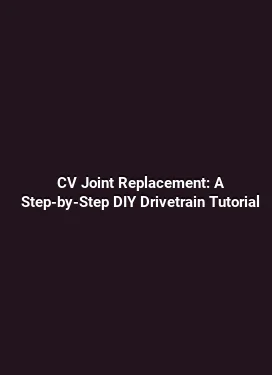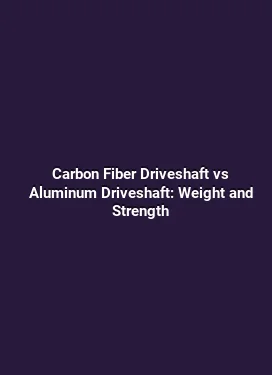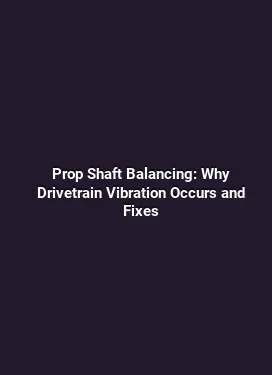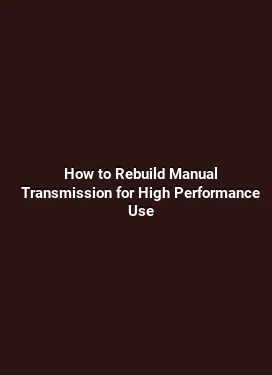Clutch Life Extension: 5 Expert Tips You Need to Know
Clutch longevity is a cornerstone of smooth shifting, predictable performance, and overall drivetrain reliability. While many drivers focus on the engine and tires, the clutch system—consisting of the clutch disc, pressure plate, flywheel, and the hydraulic or cable actuation—plays a critical role in how your vehicle handles power transfer. The following expert guidance dives into practical, hands-on strategies that go beyond basic maintenance. Each tip is framed with actionable steps, common pitfalls, and real-world examples so you can apply the knowledge to everyday driving or high-mileage scenarios.
Tip 1: Mastering Smooth Engagement and Release to Minimize Wear

One of the most impactful influences on clutch life is how smoothly the clutch is engaged and released. Abrupt engagement or aggressive slipping during takeoff introduces peak heat and uneven wear patterns on the friction material. In manual transmissions, that translates to glazing, hotspots, and progressive disc fatigue. In dual-clutch systems, mis-timing or aggressive thresholds can cause unnecessary engagement torque and chatter that ripple through the drivetrain.
To cultivate smooth operation, practice a progressive clutch release technique. Begin with a light, steady pressure on the pedal as you release the pedal, and ease off the engagement point gradually rather than snapping away from it. When starting on an incline, use a controlled application of accelerator power coordinated with gradual clutch release to prevent clutch slip. For automated manuals or torque-converter-equipped setups, pay attention to the transmission’s interpretation of pedal input or throttle kickdown—smooth throttle input paired with gentle shifts reduces abrupt torque transfer that can accelerate wear.
In practice, drivers who prioritize smoothness report lower clutch temperature spikes and more consistent engagement feel. The goal is to distribute the load transfer over a longer period and maintain steady contact pressure, thereby reducing hot spots on the clutch surface and extending life. For vehicles that experience frequent low-speed, stop-and-go operation, developing a rhythm that avoids prolonged slipping during starts is particularly beneficial.
What to monitor for this tip

Watch for signs of clutch slip, such as engine revs climbing without a proportional increase in vehicle speed, or a rising clutch pedal height before engagement. Listen for grinding or scraping noises during engagement or disengagement, and note any unusual vibration that follows a shift. If you notice these cues, it may indicate the need for adjustment, a hydraulic system check, or a component inspection to preserve clutch surface integrity.
Tip 2: Prioritize Proper Clutch Hydraulics and Cable Adjustment
Hydraulic systems and cables are the lifelines of clutch control. A misadjusted free play, air in the hydraulic line, or a failing master/slave cylinder can alter pedal feel and engagement timing, forcing the driver to compensate with greater pedal effort or uneven release. Over time, this compensation translates into uneven wear on the pressure plate and friction surface, shortening clutch life and increasing heat in the assembly.
A systematic approach to hydraulic or cable maintenance includes checking fluid levels with the vehicle on level ground, inspecting for leaks, and testing pedal return to ensure consistent engagement. Bleeding the hydraulic system to remove air pockets and replacing worn seals can restore a consistent pedal feel. If a cable-driven system is present, verify that the adjuster maintains the correct free play and that the sheath is clean, lubricated where appropriate, and free of kinks or binding. When diagnosing issues, look for signs of delayed or inconsistent clutch engagement, which often points to hydraulic or cable problems rather than the clutch disc itself.
Proactive maintenance in this area yields a tangible payoff: smoother shifts, more precise clutch control, and reduced incidental wear caused by overexertion of the release mechanism. Regular checks become especially important on vehicles with high-mileage transmission setups or aggressive driving styles, where small hydraulic inconsistencies can accumulate into noticeable clutch fatigue over time.
What to inspect and how to address
Inspect fluid color and level; dark, contaminated fluid is a red flag. Look for wet spots under the vehicle that suggest leaks in the hydraulic line. For adjustments, follow the manufacturer’s specifications for pedal free play and ensure the release bearing moves freely without binding. If the system is old or shows recurrent issues, consider a hydraulic overhaul set or a replacement clutch hydraulic kit to restore reliability and pedal feel.
Tip 3: Align Driving Habits with Transmission Type and Clutch Design
Modern transmissions come in a spectrum from traditional hydraulic-clutch layouts to dual-clutch designs and automated manual transmissions. Each design has slightly different operating windows, optimal engagement profiles, and wear patterns. Understanding the core differences helps tailor driving habits that minimize wear and maximize performance longevity. For instance, manual setups benefit from a controlled release strategy, whereas dual-clutch systems often require careful throttle management and deliberate timing to avoid abrupt torque requests at the moment of clutch engagement.
When selecting driving styles, adapt to gear ratios and shift speeds that reduce engine torque peaks at engagement. For high-torque applications, such as towing or moving heavy loads, ensure the engine torque curve aligns with the clutch’s maximum grip range to avoid slipping. In urban driving, where frequent starts-and-stops occur, maintaining steady clutch engagement with minimal slip reduces heat accumulation and preserves the friction surface integrity. For spirited driving or performance-oriented usage, practice balanced throttle input with deliberate shift timing to keep the clutch within the designed engagement envelope.
What to consider for your specific transmission type
Review the vehicle’s owner manual or service notes for the recommended engagement points, safe RPM ranges during shifts, and any notes about clutch temperature management. In some high-performance applications, clutch components may be tuned or paired with lightweight flywheels; in those cases, the driver’s technique may need further refinement to avoid sudden load transients that accelerate wear.
Tip 4: Regular Inspection and Timely Replacement Planning
Clutch components do not wear evenly; sometimes a single worn facet can indicate a broader issue, such as misalignment, contaminated friction surfaces, or hydraulic inconsistencies. Proactive inspection—especially in high-mileage vehicles or those subjected to frequent payloads—helps catch problems before they cascade into more expensive repairs. A disciplined inspection routine includes checking the flywheel surface for hot spots, glazing, or hot-rivet marks; examining the pressure plate for cracks or uneven spring loading; and evaluating the clutch disc thickness against the manufacturer’s service limits. In dual-clutch or automated systems, diagnostic scans can reveal abnormal wear patterns or solenoids sticking, which can influence engagement quality.
Planning replacement before complete failure occurs reduces the risk of sudden breakdowns and ensures smoother operation. When a clutch is nearing the end of its life, a preemptive replacement not only protects the rest of the drivetrain but also preserves drivetrain responsiveness that enthusiasts and professionals expect from a well-maintained system. Budgeting for a clutch service as part of regular maintenance, rather than waiting for a failure indicator, is a hallmark of prudent ownership.
Signs that timing is right for service
Common indicators include a slipping clutch under load, a spongy or inconsistent pedal feel, noises during disengagement, or difficulty selecting gears. If you notice a persistent smell of burning friction material, it’s a clear sign that the clutch is overheating and may require immediate attention to prevent further damage. A diagnostic check during routine service can verify wear limits and confirm whether a resurfacing or replacement is warranted.
Tip 5: Preserve Heat Management and System Cooling
Heat is the enemy of clutch life. Excessive heat accelerates friction material degradation, accelerates glazing, and can warp a flywheel. The clutch experiences peak heat during heavy load conditions, such as towing, hill starts, or sustained high-power driving. Adequate cooling of the transmission and clutch assembly is therefore essential to extend life and maintain consistent performance. This extends beyond the clutch itself to the transmission oil, cooling lines, and surrounding components that influence heat dissipation.
Practices that help manage heat include ensuring proper transmission fluid levels and using the right viscosity for your climate and usage. In heavy-duty scenarios, some drivers opt for upgraded transmission coolers and revised lubrication strategies that keep oil temperatures in check, reducing thermal stress on both the clutch and the transmission. Additionally, maintaining clean cooling channels and avoiding debris buildup around the radiator and intercooler helps sustain efficient heat dissipation. A cooler operating envelope translates into reduced wear rates on the friction surface and more predictable engagement characteristics, especially in hot weather or during extended stops with frequent starts.
Practical steps to optimize heat management
Regularly inspect cooling system performance, ensure there are no leaks, and replace radiator hoses as needed. Use high-quality transmission fluids that are appropriate for your vehicle’s design and ensure the cooling system is free of air pockets and operating at the correct coolant levels. In performance-oriented builds, consider a dedicated engine and transmission oil cooling loop, along with thermal barriers to isolate heat transfer paths that could affect clutch components.
In summary, the life of a clutch is influenced by how you drive, how you maintain the system, and how you manage heat and wear over time. By focusing on smooth engagement, reliable hydraulics, informed driving habits, proactive inspections, and effective heat management, you can significantly extend clutch life and maintain consistent performance across a wide range of operating conditions.






